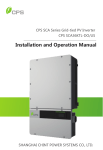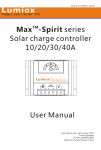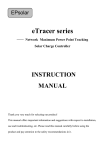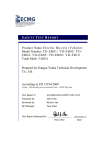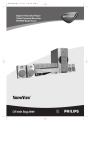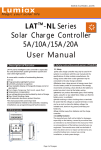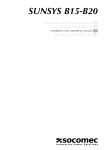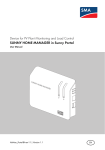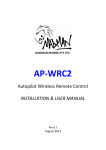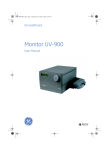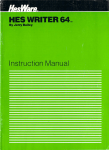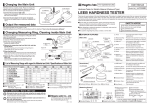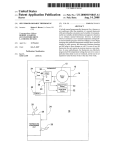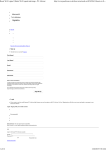Download Max-MPPT series User Manual
Transcript
www.lumiax.com Lumiax Magic your solar life TM Max -MPPT series MPPT Controller Max-MPPT series Solar charge controller User Manual User Manual_Max-MPPT series_FC Lumiax Qingdao CE, Rohs, ISO9001:2008 Subject to change without notice! Real photos Model Max-MPPT1010 Max-MPPT1510 Max-MPPT2010 Max Current 10A 15A 20A System Voltage 12/24V automatic recognition Max solar voltage 95V CAUTION: Array voltage should never exceed Max PV input voltage. Refer to the solar module documentation to determine the highest expected array Voc (open circuit voltage) as defined by the lowest expected ambient temperature for the system location. Contents 1.Safety instructions and waiver of liability............................................................................................... 2 1.1Safety Instructions 1.2Liability Exclusion 2.Pruduct Overview.............................................................................................................................................. 3 2.1Outstanding Features 2.2MPPT ..................................................................................................................................................................... 3 2.3Four Charging Stage ....................................................................................................................................... 5 3. Dimensions ........................................................................................................................... 6 4. Structure & Accessor y ........................................................................................................ 7 4.1 Structure & Characteristics 4.2Optional Accessories 5. Installation ........................................................................................................................... 8 5.1Installation Notes 5.2Mounting Location Requirements 5.3Connection.......................................................................................................................... 9 6. Starting up the controller .. ............................................................................................... 10 6.1 Self Test 6.2 System Voltage 6.3 Batter y Type 6.4 Work Mode 6.5Day/Night Threshold 7. Display Functions ............................................................................................................... 11 7.1 Batter y Capacity Display 7.2 C harge & Error D isplay(INFO) 8.Interface Description....................................................................................................................................... 12 9.Safety Features................................................................................................................................................... 13 10.Technical Datasheet....................................................................................................................................... 14 11.Conversion Efficiency Curve...................................................................................................................... 15 12.System Maintenance..................................................................................................................................... 16 13.Warranty............................................................................................................................................................. 16 1 Dear Clients, Thanks for selecting the Max-MPPT series solar controller. Please take the time to read this user manual, this will help you to make full use of many advantages the controller can provide your solar system. This manual gives important recommendations for installing and using and so on. Read it carefully in your own interest and pay attention to the safety recommendations in it please. 1, Safety instructions and waiver of liability 1.1 Safety Instructions The following symbols are used throughout this manual to indicate potentially dangerous conditions or mark important safety instructions. Please take care when meeting these symbols. WARNING: Indicates a potentially dangerous condition. Use extreme caution when performing this task. CAUTION: Indicates a critical procedure for safe and proper operation of the controller. CAUTION: 1) There are no user serviceable parts inside the controller. Do not disassemble or attempt to repair the controller. 2) Keep children away from batteries and the charge controller. 1.2 Liability Exclusion The manufacturer shall not be liable for damages, especially on the batter y, caused by use other than as intended or as mentioned in this manual or if the recommendations of the batter y manufacturer are neglected. The manufacturer shall not be liable if there has been ser vice or repair carried out by any unauthorized person, unusual use, wrong installation, or bad system design. 2 2, Over view Max-MPPT series solar controller is based on an advanced maximum power point tracking (MPPT) technology developed, dedicated to the solar system, the controller conversion efficiency up to 98%. 2.1 It comes with a number of outstanding features, such as: Innovative MPPT technology, conversion efficiency up to 98% Max MPPT efficiency >99% Many choices of battery type and working mode Clear readable display of charge/discharge, battery and error description 12V/24V automatic recognition Temperature compensation Perfect EMC & thermal design Four stage charge way: MPPT, Boost, Equalize, Float Full automatic electronic protect function Upgraded version features Based RS-485 standard Modbus protocol, to maximize their communication needs of different occasions. Support the PC monitoring software and the external display unit DU to facilitate the user to view realtime data of controller, set the control parameters. 2.2 MPPT MPPT profile The full name of the MPPT is maximum power point tracking. It is an advanced charging way which could detect the real-time power of the solar Modulel and the maximum point of the I-V curve that make the highest battery charging efficiency. Current Boost Under most conditions, MPPT technology will "boost" the solar charge current. MPPT Charging:Power Into the controller (Pmax)=Power out of the controller (Pout) Iin x Vmp= Iout x Vout * Assuming 100% efficiency. Actually, the losses in wiring and conversion exist. If the solar module's maximum power voltage (Vmp) is greater than the battery voltage, it follows that the battery current must be proportionally greater than the solar input current so that input and output power are balanced. The greater the difference between the Vmp and battery voltage, the greater the current boost. Current boost can be substantial in systems where the solar array is of a higher nominal voltage than the battery as described in the next section. 3 High Voltage Strings and Grid-Tie Modules Another benefit of MPPT technology is the ability to charge batteries with solar arrays of higher nominal voltages. For example, a 12 Volt battery bank may be charged with a 12-, 24-, 36-, or 48-Volt nominal offgrid solar array. Grid-tie solar modules may also be used as long as the solar array open circuit voltage (Voc) rating will not exceed the maximum input voltage rating at worst-case (coldest) module temperature. The solar module documentation should provide Voc vs. temperature data. Higher solar input voltage results in lower solar input current for a given input power. High voltage solar input strings allow for smaller gauge solar wiring. This is especially helpful and economical for systems with long wiring runs between the controller and the solar array. An Advantage Over Traditional Controllers Traditional controllers connect the solar module directly to the battery when recharging. This requires that the solar module operate in a voltage range that is usually below the module's Vmp. In a 12 Volt system for example, the battery voltage may range from 10.8-15 Vdc,but the module's Vmp is typically around 16 or 17V. Because traditional controllers do not always operate at the Vmp of the solar array, energy is wasted that could otherwise be used to charge the battery and power system loads. The greater the difference between battery voltage and the Vmp of the module, the more energy is wasted. I(A) P(W) MPP MPP VI curve VP curve Typical Battery Voltage Range Pmax-Px Px PWM Controller Operating Range 0 10.8V 15V 17V V(V) 0 10.8V 15V 17V V(V) Nominal 12 Volt Solar Module I-V cur ve and output power graph. Contrast with the traditional PWM controller, MPPT controller could play a maximum power of the solar panel so that a larger charging current could be supplied. Generally speaking, the MPPT controller's energy utilization efficiency is 15%~20% higher than PWM controller. Conditions That Limit the Effectiveness of MPPT The Vmp of a solar module decreases as the temperature of the module increases. In very hot weather, the Vmp may be close or even less than battery voltage. In this situation, there will be very little or no MPPT gain compared to traditional controllers. However, systems with modules of higher nominal voltage than the battery bank will always have an array Vmp greater than battery voltage. Additionally, the savings in wiring due to reduced solar current make MPPT worthwhile even in hot climates. 4 2.3 MPPT—Four Charging Stage Max-MPPT series controller has a 4-stage battery charging algorithm for rapid, efficient, and safe battery charging. U(V) Equalize Charge 14.8V 14.5V 13.7V Night MPPT or Bulk Charge Boost Charge Float Charge Night TIME MPPT or Bulk Charge In this stage, the battery voltage has not yet reached boost voltage and 100% of available solar power is used to recharge the battery. Boost Charge When the battery has recharged to the Boost voltage setpoint, constant-voltage regulation is used to prevent heating and excessive battery gassing. The Boost stage remains 120 minutes and then goes to Float Charge. Every time when the controller is powered on, if it detects neither over discharged nor overvoltage, the charging will enter into boost charging stage. Float Charge After the Boost voltage stage, the controller will reduce the battery voltage to Float voltage setpoint. When the battery is fully recharged, there will be no more chemical reactions and all the charge current transmits into heat and gas at this time. Then the controller reduces the voltage to the floating stage, charging with a smaller voltage and current. It will reduce the temperature of battery and prevent the gassing, also charging the battery slightly at the same time. The purpose of Float stage is to offset the power consumption caused by self consumption and small loads in the whole system, while maintaining full battery storage capacity. In Float stage, loads can continue to draw power from the battery. In the event that the system load(s) exceed the solar charge current, the controller will no longer be able to maintain the battery at the Float setpoint. Should the battery voltage remains below the boost reconnect charging voltage, the controller will exit Float stage and return to Bulk charging. Equalize Charge Certain types of batteries benefit from periodic equalizing charge, which can stir the electrolyte, balance battery voltage and complete chemical reaction. Equalizing charge increases the battery voltage, higher than the standard complement voltage, which gasifies the battery electrolyte. If it detects that the battery is being over discharged, the solar controller will automatically turn the battery to equalization charging stage, and the equalization charging will be 120mins. Equalizing charge and boost charge are not carried out constantly in a full charge process to avoid too much gas precipitation or overheating of battery. WARNING: Risk of explosion! Equalizing flooded batter y can produce explosive gases, so well ventilation of batter y box is necessar y. 5 3, Dimensions 73 5.8 22.5 Φ4.5 164 189 6 4, Structure & Accessor y 4.1 Structure & Characteristics ⑤ ⑥ ⑦ ①Heat Sink —dissipate controller heat ②Plastic Case —Internal protection ③Info LED Indicator —Show charging & Error status ④Battery LED Indicator —Show Battery Capacity ⑤RJ45 interface (reserved) —Connecting monitoring devices ⑥Temperature Sensor Port (reserved) — Collect temperature information, ④ ③ ⑩ ⑨ Temperature compensation. ⑦DIP switch —Battery and mode selection. ⑧ Load Terminals —Connected load. ⑨Battery Terminals —Connect the battery. ⑩Solar module terminals —Connected solar modules. ⑧ ② NO 2 1 ① ⑤ ⑥ ⑦ 4.2 Optional Accessories 4.2.1Remote Temperature Sensor (Type:RTS02) Batter y temperature data collected to accurately charge and discharge parameters of temperature compensation, the standard cable length is 2 meters (can also be customized according to user needs), RTS02 connected via interface 6. 4.2.2 Remote Display Unit (Type:DU01) Remote Display unit can display a lot of information systems work, fault information. Information via backlit LCD display, buttons and digital display is very easy to operate and read. DU01 can be easily installed in or on a frame on the wall, DU01 Standard Edition comes standard with a 1.5 m connection cable (also customized according to user needs) and a mounting frame. DU01 connected via RJ45 interface controller. 7 5, Installation CAUTION: Please read all instructions and precautions in the manual before installing! 5.1Installation Notes ⑴The solar charge controller may only be used in PV systems in accordance with this user manual and the specifications of other modules manufacturers. No energy source other than a solar generator may be connected to the solar charge controller. ⑵Before wiring installation and adjustment of controller, Always disconnect the solar modules and insurance or circuit breaker of battery terminal. ⑶Only to comply with the range of the battery charge controller. ⑷Batteries store a large amount of energy, never short circuit a battery under all circumstances. We strongly recommend connecting a fuse directly to the battery to protect any short circuit at the battery wiring. ⑸Batteries can produce flammable gases. Avoid making sparks, using fire or any naked flame. Make sure that the battery room is ventilated. ⑹Uses insulated tools and avoid placing metal objects near the batteries. ⑺Be very careful when working with batteries. Wear eye protection. Have fresh water available to wash and clean any contact with battery acid. ⑻Avoid touching or short circuiting wires or terminals. Be aware that the voltages on special terminals or wires can be as much as twice the battery voltage. Use isolated tools, stand on dry ground, and keep your hands dry. ⑼Prevent water from entering the internal controller, outdoor installation should avoid direct sunlight and rain penetration. ⑽After installation check that all connections are tight line, avoid heat accumulation caused by virtual access danger. 5.2Mounting Location Requirements Do not mount the solar charge controller outdoors or in wet rooms. Do not subject the solar charge controller to direct sunshine or other sources of heat. Protect the solar charge controller from dirt and moisture. Mount upright on the wall on a non-flammable substrate. Maintain a minimum clearance of 15cm below and around the device to ensure unhindered air circulation. Mount the solar charge controller as close as possible to the batteries. Mark the position of the solar charge controller fastening holes on the wall, drill 4 holes and insert dowels, fasten the solar charge controller to the wall with the cable openings facing downwards. >15CM WARM AIR COOL AIR >15CM 8 5.3Connection We strongly recommend connecting a fuse directly to the batter y to protect any short circuit at the batter y wiring. Solar PV modules create current whenever light strikes them. The current created varies with the light intensity, but even in the case of low levels of light, full voltage is given by the modules. So, protect the solar modules from incident light during installation. Never touch uninsulated cable ends, use only insulated tools, and make sure that the wire diameter is in accordance with the solar charge controller ’s expected currents. 1st step: Connect the battery Connect the battery connection cable with the correct polarity to the middle pair of terminals on the solar charge controller (with the battery symbol). If the system is 12V, please make sure that the battery voltage is within 10V~16V, else if the system is 24V, the battery voltage should between 20V~30V. If the polarity is correct, the LED on the controller will begin to show. 2nd step: Connect the solar module Ensure that the solar module is protected from incident light. Ensure that the solar module does not exceed the maximum permissible input current. Connect the solar module connection cable to the correct pole of the left pair of terminals on the solar charge controller (with the solar module symbol). 3rd step: Connect loads Connect the load cable to the correct pole of the right pair of terminals on the solar charge controller (with the lamp symbol). To avoid any voltage on the wires, first connect the wire to the load, then to the controller. 4th step: Final work Fasten all cables with strain relief in the direct vicinity of the solar charge controller (clearance of approx.15cm). The following diagrams provide an overview of the connections and the proper order. To avoid any voltage on the wires, first connect the wire to the controller, then to the battery, panel or load. Make sure the wire length between battery and controller is as short as possible. Recommended minimum wire size: 10A : 2.5mm²; 15/20A : 4mm². Be aware that the negative terminals of MaxMax-MPPT series Solar charge controller MPPT are connected together and therefore have the same electrical potential. If any grounding is required, always do this on the negative wires. Connecting capacitive load may trigger short circuit protection. ③ ④ ② ① ⑥ ⑤ 9 6, Starting up the controller 6. 1Se lf Tes t A s soon a s the c ontr ol l er i s s up pli e d w ith b a tt e r y, i t sta rts a sel f t e s t r outi n e . T he n the di s p la y cha nge s to norma l ope r a ti on. 6.2Sy s tem Voltag e T he contr ol le r a d justs itsel f a ut oma ti ca ll y t o 1 2V or 2 4 V s y st em v ol ta ge . A s s oon a s the b a tt e r y vo l ta g e a t th e ti me of sta rt- up i s withi n 1 0V t o 1 6V, the contr ol le r i mpli e s a 1 2V s y st em, el s e i f th e b a tt e r y volta g e is wi thin 20 V t o 30V, the contr ol l er i mpl i es a 2 4V syst e m . If the batte r y v ol ta ge i s not w ithi n th e nor ma l ope r a ting r a nge (ca .10 t o 1 6 V or ca .2 0 t o 3 0 V)a t sta rt-up, a s ta tus di s p la y a ccor di ng to th e se c ti on 7. 2 Ch ar g e & E rr or d is p la y . 6. 3B atter y Ty p e T he Max-MPP T s e r i es con troll e r a pp li e s t o L i qui d an d G e l b a tt er y, the f a ct or y de f au l t s e tting is su i ta bl e f or l i quid b a tt e r y. Ple a se r e f e r t o 8. 1.2 c ha nge se tt i ng. 6. 4 Wor k Mod e T he wo rk mode of the con troll e r i s s e l ecta bl e (Sta nda rd a nd D 2 D ), the f a ct or y de f au l t se tting is sta n d a r d . Ple a se r e f e r t o 8.1.1 cha nge setti ng. Day/Night threshold Day/Night threshold Sunset Sunrise Standard Light on Light on Light off D2D(Dusk to Dawn) 6.5 Day/Night Threshold The controller recognizes day and night based on the solar array open circuit voltage. Default: 5.0V/10.0V Sunrise Sunset 5.0/10.0V Dusk Dawn 10 7, Display Functions The controller is equipped with 6 LEDS. In normal operation, the controller shows charge or discharge status, battery capacity and load status. 7.1 Batter y Capacity Display: Yellow 2 Yellow 1 Red On, Energy of Battery <25%. Yellow 1 On, Energy of Battery is about 25~50%. Red Green Yellow 2 On, Energy of Battery is about 50~75%. Green On, Energy of Battery is about 75~100%. !The percentage corresponds to the available energy until low voltage disconnect in relation to a fully charged battery. 7.2 C harge & Error D isplay(INFO): Red Green INFO green flashing, that is charging (fast flash for MPPT charge state, slow flash for non MPPT charge state); otherwise, no charge; INFO Red On, is Error Status. For more details, please see table below. Error Loads are not supplied Display Red(INFO and Bat.) LED are lighted Red Red LED is flashing Battery is empty after a short time Red Battery is not being charged during the day Red Over voltage protection Does not recognize the system voltage Red LED on Reason Remedy Batter y is low Load will reconnect as soon as battery is recharged Fast flash: over current/short circuit of loads Switch off all loads. Remove short circuit. Slow flash: over temperature protection Auto recovery when the temperature is below set value. Battery has low capacity Change batter y Green Green LED is off Solar array faulty or wrong polarity Batter y voltage too high Red(INFO) and Green(Bat.) LED are lighted All LED Lighted (>15.5V/31V) Remove faulty connection/ reverse polarity Check if other sources overcharge the battery. If not, controller is damaged. Battery wires or battery fuse damaged, battery has high resistance Check batter y wires, fuse and batter y. The batter y voltage is not within the normal operating rang at start-up (10-16V, or 20-30V) Charge or discharge the battery to make the voltage within the normal range 11 8, Interface Description Reser ved Interface DIP Switch 8.1 DIP Switch ON 1 2 8.1.1 DIP switch stall 1 -- Work mode (Standard and D2D) settings, the default is Standard(As shown in figure). If slide the DIP switch to “ON”, the controller works in D2D mode. ON ON D2D Standard 1 2 1 2 8.1.2 DIP switch stall 2 -- Battery type selection, the default setting is liquid battery (As shown in figure). If slide the DIP switch to "ON", the battery type is selected as GEL . ON ON GEL Liquid 1 2 1 2 8.2 Reser ved Interface External temperature sensor and COM communication interface , please consult the supplier. 12 9, Safety Features Solar terminal Battery terminal Load terminal Reverse polarity Protected *1 Protected *1 Protected *2 Short circuit Protected Protected *3 Switches off immediately Switches off with delay Over current Reverse Current Over voltage Under voltage Over temp. Protected Max.100V *4 Max. 40V Switches off switches off the load if the temperature reaches the set value. *1 Controller can not protect itself in a 24V system when polarity of battery or solar is reversed. *2 Controller can protect itself, but loads might be damaged. *3 Battery must be protected by fuse, or battery will be permanently damaged. *4 The solar panel voltage should not exceed this limit for a long time as voltage protection is done by a varistor. CAUTION: The combination of different error conditions may cause damage to the controller. Always remove the error before you continue connecting the controller. 13 10, Technical Datasheet Electric Max-MPPT1010 Max-MPPT1510 Max-MPPT2010 Max solar current 10 A 15 A 20 A Max load current 10 A 15 A 20 A Max PV input power 12V:150W, 24V:300W 12V:225W, 24V:450W 12V:300W, 24V:600W System voltage 12V/24V automatic recognition Max conversion efficiency >98% Max MPPT efficiency >99% Max solar voltage 95 V Max power consumption 15mA Battery Float voltage 13.7V/27.4V ( 25℃ ) Boost voltage 14.5V/29.0V ( 25℃ ) Equal voltage 14.8V/29.6V ( 25℃ ) (Liquid) Load disconnect voltage 11.2~11.8V/22.4~23.6V Load reconnect voltage 12.5V/25.0V Day/Night threshold 5.0V/10.0V Batter y type Liquid, Gel Temperature compensation -4.17 mV/K per cell (Boost、Equal), -3.33 mV/K per cell (Float) Max batter y voltage 40 V Others Dimensions/Weiht 164*189*73mm / 700g Operating temperature -40℃ ~ +60 ℃ Storage temperature -40℃ ~ +80 ℃ Relative humidity 10%~90% Case protection IP32 164*189*73mm / 900g Non-condensation 14 11, Conversion Efficiency Cur ve Max-MPPT 12V Efficiency 100 99 98 17V 97 Efficiency(%) 96 95 34V 94 68V 75V 93 92 91 90 89 88 0 20 40 60 80 100 120 140 160 180 200 220 240 260 280 300 Output power(W) Max-MPPT 24V Efficiency 100 99 98 97 Efficiency(%) 96 34V 95 94 68V 93 92 85V 91 90 89 88 0 50 100 150 200 250 300 350 400 450 500 550 600 Output power(W) 15 12, System Maintenance In order to maintain the best self-lasting performance, we recommend the following checks twice a year. Verify that the controller is securely mounted in a clean, dr y environment. Confirm the airflow around the controller is not blocked to live, to remove any dirt or debris from the heat sink . Check all exposed wire is due to the sun, and other objects around the friction, dr y rot, insect or rodent damage as a result of damage to the insulation. If necessar y, repair or replace wires. Tighten all electrical connections screw terminals on the recommendation. Check all system components in the ground, to verify all ground wires are securely and properly grounded. Check all the terminals to see if there is corrosion, insulation damage, heat or burning / discoloration signs, tighten the terminal screws to the recommended torque. Check for dirt, nesting insects and corrosion, as required cleanup. If the arrester has expired, the timely replacement of failed arrester to prevent damage caused by lightning controller even users of other devices. CAUTION: Risk of electric shock!!! When the above operations controller must ensure that all power is disconnected, and then make the appropriate checks or operation! 13, Warranty The controller is warranted to be free from defects for a period of TWO (2) years from the date of shipment to the original end user. Maintenance procedures: Before calling ser vice, check user manual to determine the controller does have a problem. If you can not solve a problem with the controller will be delivered back to the company, freight prepaid, and provide the relevant date and place of purchase information. In order to enjoy the detailed reasons for the rapid repair warranty ser vice, return the product must be marked with model number, serial number, and failure, and the type of Module and related parameters, the batter y and the load of the system; this information to quickly resolve your maintenance is ver y important requirement . If the reason due to customer misuse or failure to follow this manual operation, resulting in damage to the controller, the Company shall not be responsible! 16 Lumiax Magic your solar life! Qingdao Skywise Technology Co., Ltd. NO.192, Zhuzhou Road, Qingdao Tel:0086-532-80776031 Fax: 0086-532-80776757 E-mail: [email protected]




















